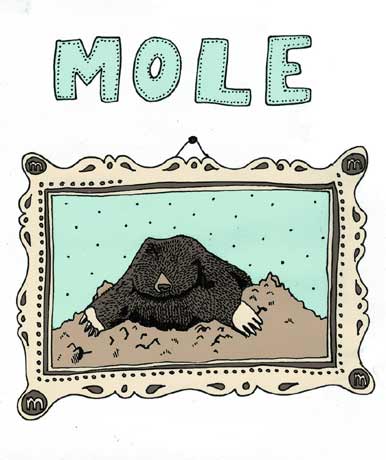相信凡是看過捷克經典動畫片《鼴鼠的故事》的人都會被那只圓頭圓腦的黑色小鼴鼠所吸引,這個幽默快樂的小家伙用俏皮可愛的一舉一動征服了全世界無數的孩子甚至成人。動畫里的鼴鼠總是喜歡帶著鏟子挖來挖去,掘起一堆堆的小土坡。你知道嗎,真正的鼴鼠也隨身帶著“小鏟子”呢,那就是它強有力的兩只前爪,用以幫助它更好地適應地下掘土生活;鼴鼠很少鉆出地面,它們可是名副其實的“地下工作者”。當你行走在柔軟的草坪上時,如果看見一些小土丘,那么,也許可愛的鼴鼠就在離你不遠的地方哦!

卓言 選 王雪嬌 譯
|
Moles spend almost their entire lives underground—small weak eyes, velvety[1] fur, and small hips for turning around in tight places. Moles also have broad front feet, the toes of which terminate in stout claws faced outward for digging. A mole can dig its way through an amazing 14 meters of soil in just one hour! Moles measure around 14 centimeters in length and have a three-centimeter tail. The moles tail is carried erect and the hairs on the tip give the mole information about its surroundings by brushing against the tunnel roof. Moles sleep, feed and breed in their tunnels. Moles occasionally appear above ground at the top of one of their characteristic molehills[2], and even then usually only the head and pink fleshy snout is revealed. Moles are carnivores feeding almost exclusively small invertebrate animals living underground such as earthworms and the larvae of beetles and flies.[3] A mole may also occasionally catch small mice at the entrance to its burrow. Because their saliva contains a toxin that can paralyze earthworms, moles are able to store their still living prey for later consumption. They construct special underground “larders” for just this purpose. Researchers have discovered such larders with over a thousand earthworms in them. A mole’s preferred habitats are wooded hilly districts. Moles have a well-developed sense of orientation retaining a mental plan of their complex layout of underground tunnels. Moles burrow in lawns, raising molehills and killing the lawn, for which they are sometimes considered pests. They can undermine plant roots, indirectly causing damage or death. Though moles are the bane[4] of many lawn owners, they make a significant positive contribution to the health of the landscape. Their extensive tunneling and mound building mixes soil nutrients and improves soil aeration[5] and drainage. Moles also eat many lawn and garden pests. |
鼴鼠的一生幾乎都是在地下度過的——它們眼睛小視力弱,體毛(絲絨般)柔軟,臀部短小適于在狹窄的地方來回轉身。鼴鼠還擁有寬大的前肢,結實的前爪上長有外翻的足趾,很適于掘土。一只鼴鼠在一個小時內居然可以挖穿14米長的地道! 鼴鼠身長約14厘米,外加一條3厘米長的尾巴。鼴鼠的尾巴是直立的,尾尖的毛可以通過擦拂隧道頂部向鼴鼠傳達周圍環境的信息。鼴鼠的飲食、起居,還有繁殖都在它們的地道里進行。它們偶爾會鉆出地面,出現在其特有的某個鼴鼠丘頂上,即使在這時,它們通常也只會露出腦袋和粉嘟嘟的肉嘴。 鼴鼠是食肉動物,幾乎能吃所有生活在地下的小無脊椎動物,比如蚯蚓、甲蟲和蠅類的幼蟲。鼴鼠偶爾還能在自己的洞口處抓住一些小老鼠。由于它們的唾液中含有一種能夠麻痹蚯蚓的毒素,鼴鼠可以將這些活的獵物儲存起來供以后享用。它們還為此建造了專門的地下“貯藏庫”。研究人員們曾發現藏有一千多條蚯蚓的這類貯藏庫。 鼴鼠喜歡棲居在樹葉繁茂的山丘地區。鼴鼠方向感很強,心中對它們復雜的地下隧道布局很有規劃。鼴鼠在草坪下挖洞,隆起的鼴鼠丘會破壞草坪,因此它們經常被看作是有害動物。它們還會破壞植物的根部,從而間接給植物造成傷害或死亡。盡管鼴鼠對許多草坪主人來說都是禍害,它們對這些自然景觀的健康卻做出了積極重要的貢獻。它們挖的大量洞穴通道和堆起的土墩都會使土壤中的養分得以充分融合,從而提高了土壤的通風和排水性能。鼴鼠還可以吃掉很多草坪和花園里的害蟲。 (來源:英語學習雜志) |
|
Vocabulary: 1. velvety: 絲絨(或天鵝絨)般(光滑柔軟)的。 2. molehill:(由鼴鼠打洞扒出的泥土堆成的)鼴鼠丘。可喻指“無意義的小事,小困難(或障礙)”,英文中有句形象的俗語:make a mountain out of a molehill,意思就是“小題大做”。 3. invertebrate: 無脊椎的;larvae: 幼蟲,是larva的復數形式, 4. bane: 災星,禍根。 5. aeration: 通風,空氣流通。 |